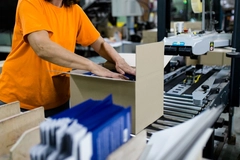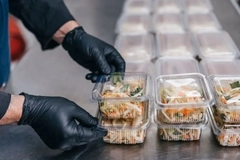Tipa CEO: How compostable packaging could help feed the world
08 Dec 2022 --- Tipa calls for an increase in bio-based packaging solutions, rising publicity and investment in composting. The company highlights the necessity for packaging innovation to reduce food waste and the key roles that governments have in the space.
Daphna Nissenbaum, co-founder and CEO at Tipa gives PackagingInsights an inside look into the company’s materials, the advantages of compostable packaging solutions over conventional plastics and how consumers dispose of their packaging properly.
“A third of the world’s food goes to waste or is thrown away. With food, packaging is also discarded in large quantities. This results in a large amount of discarded plastic that never disappears. Meanwhile, climate change and soil degradation make growing enough food to feed an expanding population harder.”
Composting – the circular solution
The solution lies in the problem itself, explains Nissenbaum. “If composted, waste food could slow climate change and improve soil quality. When food waste, along with packaging like paper, cardboard and other compostable options, breaks down in composting facilities or backyard compost piles, they don’t produce methane, resulting in carbon-rich soil that can be used anywhere from potted plants to commercial agricultural fields.”
She continues by saying that composting “can change the world” if it is given the same publicity and investment recycling has received.
.png) Tipa’s materials are all fully compostable and are between 20 to 80% bio-based.Composting needs a larger government effort, including building and strengthening suitable waste streams for compostables; incentivizing brands to deploy compostable materials in their packaging, rather than continue to churn out conventional, polluting plastics; promoting and educating the citizens in using compostables and dispose of them properly, she says.
Tipa’s materials are all fully compostable and are between 20 to 80% bio-based.Composting needs a larger government effort, including building and strengthening suitable waste streams for compostables; incentivizing brands to deploy compostable materials in their packaging, rather than continue to churn out conventional, polluting plastics; promoting and educating the citizens in using compostables and dispose of them properly, she says.
The Tipa co-founder and CEO explains that besides presenting information about the product and protecting it during shipment, packaging also extends the product’s shelf life and prevents waste. An example would be a banana which has a pill that protects it, but if packaged properly, it will last longer.
“Then again, if you use conventional plastic packaging, you may extend the fruit’s shelf life, but you will also increase the amount of non-disposable plastic in the environment.”
Shelf life extension issues
Nissenbaum highlights that plastics have a significant carbon footprint and emit 3.4% of global greenhouse gas emissions.
“All types of packaging have a high carbon footprint for production, not just plastic packaging. Tipa doesn’t claim to have a low carbon footprint in terms of production. The difference for us is end-of-life. We design our packaging to safely decompose into organic matter after use and to leave zero waste.”
Tipa’s packaging is based on a “unique” technology that enables it to decompose in an oxygen, heat and moisture-rich environment. When properly stored, this technology allows the packaging to have a shelf life of several months.
While some applications have shown not to be home compostable, unlike declared, Tipa says its solutions are indeed home compostable.
“Our solutions are home compostable. They are all certified by globally established bodies according to the highest standards for compostable certifications. To adhere to compost standards, the material needs to biodegrade in a timely manner and demonstrate that it is free of toxins and heavy metals.”
“Tipa’s materials are all fully compostable and are between 20 to 80% bio-based. The remaining percentage is made of fully compostable fossil-based polymers. Tipa is always looking for ways to use more bio-based material, but never at the expense of compostable end-of-life,” asserts Nissenbaum.
 Composting “can change the world” when given the same publicity and investment recycling has received, highlights Nissenbaum.Proper disposal
Composting “can change the world” when given the same publicity and investment recycling has received, highlights Nissenbaum.Proper disposal
Nissenbaum says that we must ask ourselves the question: How do consumers properly dispose of your food packaging solutions? “Trash is put in the bin and immediately forgotten.”
“At Tipa, we are working to put things in order: First, it is crucial that consumers read the labels on our packaging to determine whether it’s home compostable or industrially compostable. If it is home compostable, it needs to be placed in a home composter alongside organic waste.”
To determine whether the package can be disposed of with other organic waste, it is recommended to check the local waste treatment laws, Nissenbaum explains.
“If it’s industrially compostable, we recommend checking local waste treatment facilities to find the closest industrial composter. It is important to note that compostable packaging is absolutely not recyclable and will contaminate recycling streams. For packaging to decompose properly, one should know how to use a home composter.”
“The COP27 is not a role model when it comes to encouraging innovation. As an innovator, Tipa strives to reduce plastic pollution with cutting-edge products. In places where plastic has an essential and life-supporting role, such as keeping food fresh in transit or keeping hospital equipment sterile, we aim to replace it with compostable packaging,” concludes Nissenbaum.
By Natalie Schwertheim












